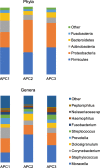Pediatric asthma comprises different phenotypic clusters with unique nasal microbiotas
- PMID: 30286807
- PMCID: PMC6172741
- DOI: 10.1186/s40168-018-0564-7
Pediatric asthma comprises different phenotypic clusters with unique nasal microbiotas
Abstract
Background: Pediatric asthma is the most common chronic childhood disease in the USA, currently affecting ~ 7 million children. This heterogeneous syndrome is thought to encompass various disease phenotypes of clinically observable characteristics, which can be statistically identified by applying clustering approaches to patient clinical information. Extensive evidence has shown that the airway microbiome impacts both clinical heterogeneity and pathogenesis in pediatric asthma. Yet, so far, airway microbiotas have been consistently neglected in the study of asthma phenotypes. Here, we couple extensive clinical information with 16S rRNA high-throughput sequencing to characterize the microbiota of the nasal cavity in 163 children and adolescents clustered into different asthma phenotypes.
Results: Our clustering analyses identified three statistically distinct phenotypes of pediatric asthma. Four core OTUs of the pathogenic genera Moraxella, Staphylococcus, Streptococcus, and Haemophilus were present in at least 95% of the studied nasal microbiotas. Phyla (Proteobacteria, Actinobacteria, and Bacteroidetes) and genera (Moraxella, Corynebacterium, Dolosigranulum, and Prevotella) abundances, community composition, and structure varied significantly (0.05 < P ≤ 0.0001) across asthma phenotypes and one of the clinical variables (preterm birth). Similarly, microbial networks of co-occurrence of bacterial genera revealed different bacterial associations across asthma phenotypes.
Conclusions: This study shows that children and adolescents with different clinical characteristics of asthma also show different nasal bacterial profiles, which is indicative of different phenotypes of the disease. Our work also shows how clinical and microbial information could be integrated to validate and refine asthma classification systems and develop biomarkers of disease.
Keywords: 16S rRNA; Asthma; Microbiome; Nose; Phenotype.
Conflict of interest statement
Ethics approval and consent to participate
All participants in this study were part of The AsthMaP-2 Project. AsthMaP-2 and the work presented here was approved by the Children’s National Medical Center Institutional Review Board. Written consent was obtained from all independent participants or their legal guardians using the IRB-approved informed consent documents.
Consent for publication
Not applicable
Competing interests
The authors declare that they have no competing interests.
Publisher’s Note
Springer Nature remains neutral with regard to jurisdictional claims in published maps and institutional affiliations.
Figures


Similar articles
-
Distinct nasal airway bacterial microbiotas differentially relate to exacerbation in pediatric patients with asthma.J Allergy Clin Immunol. 2019 Nov;144(5):1187-1197. doi: 10.1016/j.jaci.2019.05.035. Epub 2019 Jun 13. J Allergy Clin Immunol. 2019. PMID: 31201890 Free PMC article.
-
Nasopharyngeal Microbiome Diversity Changes over Time in Children with Asthma.PLoS One. 2017 Jan 20;12(1):e0170543. doi: 10.1371/journal.pone.0170543. eCollection 2017. PLoS One. 2017. PMID: 28107528 Free PMC article.
-
Longitudinal Changes in Early Nasal Microbiota and the Risk of Childhood Asthma.Pediatrics. 2020 Oct;146(4):e20200421. doi: 10.1542/peds.2020-0421. Epub 2020 Sep 15. Pediatrics. 2020. PMID: 32934151
-
Association of upper airway bacterial microbiota and asthma: systematic review.Asia Pac Allergy. 2022 Jul 29;12(3):e32. doi: 10.5415/apallergy.2022.12.e32. eCollection 2022 Jul. Asia Pac Allergy. 2022. PMID: 35966153 Free PMC article. Review.
-
Does lung microbiome play a causal or casual role in asthma?Pediatr Pulmonol. 2018 Oct;53(10):1340-1345. doi: 10.1002/ppul.24086. Epub 2018 Jun 26. Pediatr Pulmonol. 2018. PMID: 29943915 Review.
Cited by
-
Nasal Microbiome and Its Interaction with the Host in Childhood Asthma.Cells. 2022 Oct 7;11(19):3155. doi: 10.3390/cells11193155. Cells. 2022. PMID: 36231116 Free PMC article. Review.
-
Human airway and lung microbiome at the crossroad of health and disease (Review).Exp Ther Med. 2022 Nov 22;25(1):18. doi: 10.3892/etm.2022.11718. eCollection 2023 Jan. Exp Ther Med. 2022. PMID: 36561630 Free PMC article. Review.
-
Bacterial Microbiota of Asthmatic Children and Preschool Wheezers' Airways-What Do We Know?Microorganisms. 2023 Apr 28;11(5):1154. doi: 10.3390/microorganisms11051154. Microorganisms. 2023. PMID: 37317128 Free PMC article. Review.
-
Airway Microbiota Profiles in Children With and Without Asthma: A Comparative Study.J Asthma Allergy. 2025 Mar 5;18:349-361. doi: 10.2147/JAA.S498803. eCollection 2025. J Asthma Allergy. 2025. PMID: 40061431 Free PMC article.
-
The optimal duration of antimicrobial therapy for lower respiratory tract infection in patients with neuromuscular disorders based on a clone library analysis of the bacterial 16S rRNA gene sequence.Int J Infect Dis. 2020 Nov;100:396-401. doi: 10.1016/j.ijid.2020.09.035. Epub 2020 Sep 17. Int J Infect Dis. 2020. PMID: 32950736 Free PMC article.
References
-
- National Institute of Allergy and Infectious Diseases. NIAID Strategic Plan 2013. 2013. Available from: http://www.niaid.nih.gov/about/whoweare/planningpriorities/Pages/default.... Last accessed: 6 Jan 2015.
Publication types
MeSH terms
Substances
Grants and funding
LinkOut - more resources
Full Text Sources
Other Literature Sources
Medical

